
The TurboGrafx-16, known as the PC Engine outside North America, is a home video game console designed by Hudson Soft and sold by NEC Home Electronics. It was the first console marketed in the fourth generation, commonly known as the 16-bit era, though the console has an 8-bit central processing unit (CPU) coupled with a 16-bit graphics processor. It was released in Japan in 1987 and in North America in 1989. In Europe, the console is known as the PC Engine, after the Japanese model was imported and distributed in the United Kingdom and France from 1988. In Japan, the system was launched as a competitor to the Famicom, but the delayed United States release meant that it ended up competing with the Sega Genesis and later the Super NES.

Air Zonk, known in Japan as PC Denjin, is a horizontally scrolling shooter released for TurboGrafx-16 in 1992. Air Zonk was an attempt to update the company's image via a modern, punkish character called Zonk, who bears a purposeful resemblance to the TurboGrafx-16's caveman mascot, Bonk.

Wonder Boy III: The Dragon's Trap, known as Monster World II in Japan, is a platforming action-adventure video game developed by Westone as part of Sega's Wonder Boy series. It was published by Sega and released for the Master System in 1989 and for the Game Gear in 1992 as Wonder Boy: The Dragon's Trap. It was ported by Hudson Soft and released in 1991 for the TurboGrafx-16/PC Engine under the name Dragon's Curse. It was also ported in 1993 by Brazilian company Tec Toy under the title Turma da Mônica em o Resgate, with the game retooled to include characters from Brazilian comic book series Monica's Gang. A remake developed by Lizardcube and published by DotEmu, titled Wonder Boy: The Dragon's Trap, was released in April 2017.
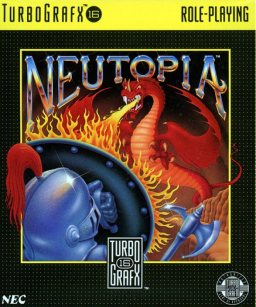
Neutopia is an overhead action-adventure video game developed by Hudson Soft. It was released by Hudson for the PC Engine in Japan on November 17, 1989. It was then released by NEC for the TurboGrafx-16 in North America in 1990. It was re-released for the Virtual Console service worldwide for the Wii in 2007; it was re-released for the PlayStation Network in Japan in 2010 and in North America in 2011. It was re-released for the Wii U on April 16, 2014 in Japan, and in USA and Europe in 2017. The game takes place in the land of Neutopia, where the evil demon Dirth has captured Princess Aurora and has stolen the eight ancient medallions which contain the wisdom and power necessary to maintain peace and prosperity throughout the land. It is up to the protagonist Jazeta to retrieve the eight medallions, defeat Dirth, rescue Princess Aurora, and save the land and its people.

Galaga '88 is a 1987 fixed shooter arcade video game by Namco. It is the third sequel for Galaxian. It features significantly improved graphics over the previous games in the series, including detailed backgrounds, larger enemies and greater ship details. The game runs on Namco System 1 hardware.

Galactic Pinball is a pinball video game for Nintendo's Virtual Boy game console. The game was released on July 21, 1995 in Japan and on August 14, 1995 in the United States. It is set in the Milky Way galaxy, and has players maneuvering a puck around one of four pinball tables available in the game. The Virtual Boy's standard red-and-black color scheme resulted in criticism of this and other games on the platform for causing nausea, headaches, and eye strain. It also uses parallax, which allows the game to display three-dimensional effects. It has received a mixed reception; it was praised for its authenticity, while reception to its physics and controls were mixed. It has also received criticism for its lack of ambition and originality.
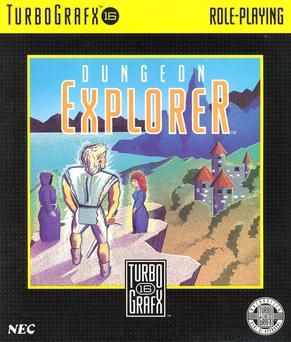
Dungeon Explorer is an action role-playing video game developed by Atlus for the TurboGrafx-16 and originally published by Hudson Soft in Japan on March 4, 1989, and later in North America by NEC on November 15 of the same year. The first installment in the eponymous franchise, the game is set in the land of Oddesia, which has been overrun by an alien race and where players assume the role of one of eight main characters tasked with recovering the Ora stone to kill the alien king Natas. Co-directed by Kazutoshi Ueda and Yōsuke Niino, the title was created by most of the same team that would work on later several projects such as entries in the Megami Tensei series. Though it was initially launched for the TurboGrafx-16, it was later re-released through download services for various consoles.

Neutopia II is a 1991 action-adventure/action role-playing video game developed and published in Japan by Hudson Soft and in North America by Turbo Technologies for the TurboGrafx-16. It is the sequel to Neutopia, which was released earlier in 1989. In the game, the player takes control of Jazeta's son, who embarks on a quest to both save his father and defeat the returning evil demon Dirth.
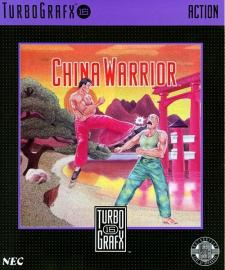
China Warrior, known as The Kung Fu in Japan, is a beat 'em up video game created in 1987 by Hudson Soft for the PC Engine/TurboGrafx-16. The game received mixed reviews upon release, with praise for its large sprite graphics but criticism towards its gameplay.

Gunhed, known as Blazing Lazers in North America, is a vertically scrolling shooter game by Hudson Soft and Compile, based on the Japanese film Gunhed. The title was released in 1989, for the PC Engine in Japan and re-skinned for the TurboGrafx-16 in North America, with Gunhed unofficially imported for the PC Engine in Europe. In the game, a fictional galaxy is under attack by an enemy space armada called the Dark Squadron, and this galaxy's only chance for survival is the Gunhed Advanced Star Fighter, who must destroy the Dark Squadron and its Super Weapons. The gameplay features fast vertical scrolling and a wide array of weapons for the player to use.

The Legendary Axe is a horizontal platform video game for the TurboGrafx-16. It was developed and published by Victor Musical Industries in Japan and by NEC in North America. It was released in Japan on September 23, 1988 and in North America as a TurboGrafx-16 launch title on August 29, 1989. In the game, the player controls Gogan, a barbarian whose girl, Flare, was kidnapped by the cult of Jagu. The player must navigate through six platforming levels, armed with a legendary axe named "Sting" to defeat Jagu and his minions and rescue Flare. The game features a rechargeable "strength meter" that determines how much damage is dealt from the axe to enemies.
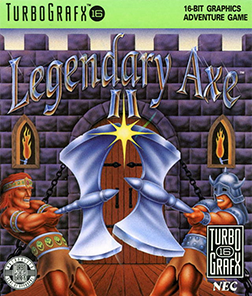
The Legendary Axe II is a horizontal platform video game created in 1990 by Victor Musical Industries. It is the follow-up to The Legendary Axe.

Chew Man Fu is a 1990 action video game developed by Now Production and published in Japan by Hudson Soft and in North America by NEC for the TurboGrafx-16.

Psychosis is a side scrolling shooter type game for the TurboGrafx-16/PC Engine. It was released in 1990 by NAXAT Soft, which also released the games Alien Crush and Devil's Crush When released it was praised for its colorful graphics and original backstory. It was released on the Wii Virtual Console in all nations in 2008.

Devil's Crush is a pinball video game developed by Compile for the TurboGrafx-16 and released in 1990. The second installment in the Crush Pinball series after Alien Crush, the game has an eerie occult theme with skulls, skeletons, and demons. It was later followed by Jaki Crush and Alien Crush Returns.

Drop Off is a Breakout clone by Data East. The game was published in 1990 for the PC Engine as Drop Rock Hora Hora and subsequently saw a US release for the TurboGrafx-16 as Drop Off.

Gate of Thunder is a 1992 scrolling shooter video game developed by Red Company and published by Hudson Soft for the TurboGrafx-CD. It was the first game released in North America to support the Super CD-ROM² format and served as one of the pack-in games for the TurboDuo, a two-in-one system which runs both TurboGrafx-CD and TurboGrafx-16 titles, where it was bundled with Bonk's Adventure, Bonk's Revenge and Bomberman on the same disc. In the game, the player controls the Hunting Dog space fighter craft, piloted by space cop Hawk. Alongside his ally Esty, piloting the Wild Cat support ship, Hawk must stop General Don Jingi and his Obellon armada from obtaining the powerful "Starlight" energy source from planet Aries.
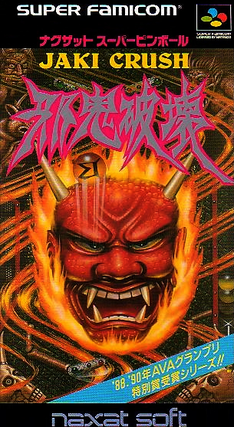
Jaki Crush is a pinball video game developed by Compile and published by NAXAT Soft. Jaki Crush was released exclusively in Japan for the Super Famicom in 1992. The game is the third in the Crush Pinball series, and was preceded by Alien Crush and Devil's Crush on the TurboGrafx-16.

Cyber Core is a 1990 vertically scrolling shooter video game developed by Alfa System and published in Japan by Information Global Service (IGS) and in North America by NEC for the TurboGrafx-16. Set in the year 2269 where Earth has been overrun by an alien race known as Hyper Insects, the player controls a Chimera bio-fighter craft, piloted by the enforcer Rad Ralph in order to fend off the invaders and reclaim the planet. Similar to Dragon Spirit, Ralph has a projectile weapon for destroying air-based enemies and a bomb for destroying ground-based enemies.

Demon's Tilt is a pinball video game by American developer Adam Ferrando under his handle WIZNWAR, released on Steam Early Access in January 2019, with eventual publication on Microsoft Windows, Mac OS, PlayStation 4, Xbox One, and Nintendo Switch in December 2019. The game features occult inspiration pulled from H.P. Lovecraft, tarot and other horror themes. The game has been called a spiritual successor to the Crush Pinball series of pinball video games, namely Devil's Crush. A sequel, Xenotilt, is currently in development.




















